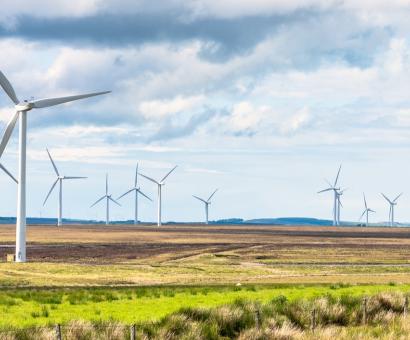Rural Land Market Insights 2024
This is the third installment in the Rural Land Market Insights Report series with the Scottish Land Commission. It draws on in-depth interviews with 17 land agents from a range of sectors (agriculture, forestry and estates) operating across Scotland. Land agents were asked how the market performed for the calendar year of 2023, and we report on recent and emerging trends occurring in all sectors of the land market.
Overall impressions of the market
In 2023, the land market witnessed a slowdown compared to previous years and was described as "sluggish", with sentiments softening and transactions taking longer to close.
Economic factors contributed to weakened market sentiment, including high interest rates which made borrowing money harder, and the cost-of-living crisis which drove certain commodities upwards (making it less profitable to manage land-based business). Institutional investors started turning away from land due to lower yields, opting for alternative investments like government bonds or gold.
Government policies, including those relating to land management and short-term lets, introduced uncertainty and impacted market dynamics.
Supply remained restricted in 2023, while demand slightly weakened, leading to a cautious market environment. Uncertainty surrounding agricultural subsidies and the carbon market influenced both supply and demand dynamics.
Land prices remained consistent or slightly increased despite the slower market, with the exception of marginal hill land which came back down from previous highs.
Off-market transactions persisted but decreased slightly with estates experiencing a reduction in off-market sales. Prime arable land saw higher off-market activity than previously, particularly between neighbours, driven by factors like rollover funds. A semi-off-market trend emerged where estates were marketed to select buyers privately.
Farmland
Mixed dynamics were observed in the farmland market, with some sectors experiencing growth while others faced challenges. Farmers seeking economies of scale drove demand for land expansion on the back of two quite profitable years. Rollover funds played a significant role in driving market activity in 2023, particularly from those who sold to forestry or natural capital in 2020-21.
Limited supply and sustained demand maintained land prices, with the highest quality arable land remaining highly desirable.
Mixed farming units attracted newfound interest due to their blend of food production and nature restoration potential, which may prove beneficial when considering the new agricultural support scheme.
Limited supply characterised the farmland market in 2023, with motivations for selling including retirement planning, inheritance distribution, and debt consolidation. In some cases, economic factors influenced larger farmers to offload small parcels of land to reduce financial strain.
Forestry
The forestry sector saw a significant slowdown compared to previous years. A drop in the number of properties offered for sale and a decrease in sold properties were noted.
Two exceptionally large plots remained on the market due to timing issues, but also hinted at an overall slowing down of the forestry market.
Factors such as rising costs, regulatory uncertainties, and lower timber prices affected the market. Confidence decreased due to unclear policy direction and lengthy approval processes. A comparison to the housing development market was drawn, suggesting a potential emerging business model of purchasing land, obtaining planting permission, and selling it at a premium, due to the issues around attaining permissions.
Two distinct buyer groups continued to emerge: commercial forestry investors and natural capital investors. Commercial forestry investors focused on long-term timber price outlook and domestic timber scarcity, with long-term predictable cash flows remaining appealing. Natural capital investors were interested in different land, which had the potential for native tree planting and peatland restoration.
Land suitable for natural capital schemes
Purchasing land for natural capital purposes slowed considerably compared to previous years. Carbon schemes were primarily discussed, with more issues surrounding woodland carbon compared to peatland carbon.
Most applications for carbon schemes were from existing landowners and farmers rather than new landowners who have recently acquired land for this purpose. Companies were instead leaning towards forming partnerships with landowners instead of purchasing land themselves. Alternative models, such as leasing land or funding projects for future credits, gained popularity.
The introduction of biodiversity credits was anticipated, raising questions about their stacking with carbon credits and potential effects on the land market.
Estates
Estates attracted a range of buyers with different motivations. A distinction was made between 'traditional' buyers (typically self-made individuals) whose motivations were around amenity use and social development, and institutional investors driven by natural capital motivations. Natural capital-driven buyers typically out-competed traditional buyers in terms of purchasing power. Institutional investors favoured estates with fewer enterprises and residential properties attached.
Other buyers: renewable energy developers and house buyers
Renewable energy developers, particularly windfarm developers, showed slightly increased activity compared to previous years. However, the cost of these schemes will be affected by the introduction of biodiversity credits in future years.
House builders slowed their buying due to macro-economic factors and regulatory changes.
Read the report in full below.
Report authors: Ian Merrell (SRUC), Hanna Wheatley (SLC), Lorna Pate (SRUC), James Glendinning (SRUC), Bryony Nelson (SRUC) and James MacKessack-Leitch (SLC).
Commissioned by the Scottish Land Commission.
With thanks to participants and Agencies who voluntarily provided their time and expertise to the report.






